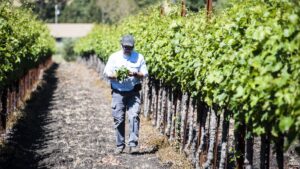Growing Together Summer 2024
Weather the Wine Grape Market Storm with Attention to Smart Crop Inputs and Market Presence
The outlook is bearish for the 2024 Northern California wine grape marketplace. Such economics may have growers thinking of ways to cut costs to keep their operations viable until more favorable market prices return. The right strategy depends on the specific market outlet and location, general grape supply and demand, and incremental steps growers can take to manage costs without making wholesale changes that could endanger contracts with wineries.
We talked to three Grow West team members — PCA and CCA Andy Wilson in Sonoma, PCA Bruce Gradek in Sonoma and Geyserville and North Coast Regional Manager Devin Gordon — in the North Coast region to get a feel for what goes into those strategies and how growers can endure the current economic cycle so they’re well-positioned when markets improve. Though the effects of bearish market conditions are inevitable for growers, there are a few viticultural and marketplace adjustments that can make it a little easier to weather that storm.
Q: What are some things growers can do to manage costs in what’s expected to be a down year?
A: Many North Coast wine grape crop protection applications are necessary to meet the quality standards of the region’s wineries and can’t be cut entirely. But things like mechanization to supplement or replace human labor and incremental changes in application timing can displace or lessen some crop input costs.

“Herbicide applications are a lot less expensive than controlling weeds by hand. Look at ways to mechanize operations from canopy management to how you harvest,” Wilson said. “Anything that can save on labor can help, because labor hasn’t gotten any cheaper.”
Fungicides — and their costs — are and will continue to be a necessity. But working with their PCAs and other trusted crop advisers, growers can optimize products and applications to maximize their efficacy and cost efficiency, Gordon said.
Growers can look at ways to generate incremental savings by applying lower-cost fertilizer products or adjusting things like application timeframes. But with some products, Gradek recommends exercising caution in switching just to cut costs.
For growers for whom dusting sulfur is an option, multiple applications can be utilized to save on cost. With a lot of attention on fungicides as a potential cost savings, choosing specific products by cost alone may compromise previous resistance management efforts. It’s important to mix or rotate chemistries,” Gradek said. “Though some may cut corners on cultural practices like suckering and leafing, neglecting the canopy environment often leads to increased pathogen issues.”
Growers can also choose to forego things like planting cover crops and post-harvest fertilization, Gradek added. Passing on those may have longer-term impacts on soil health and vine productivity, so he recommends weighing those decisions carefully so they justify the cost savings in both the short and long terms.
Q: How should growers balance efforts to manage costs this year with attention to future years’ productivity?
A: Many larger producers already remove and replant as much as five percent of their total crop given vineyards’ productive life cycles and depreciation on a vineyard’s overall productivity. In theory — if doing so won’t dramatically impact vineyard delivery commitments or production in general — replanting even more in an economically bearish year is one way to help sustain output in future years.
“I have customers who have decided just to remove vines that don’t meet quality standards for what their market value is this year,” Wilson said. “They’re doing that based on things like a variety in the wrong spot, the age of the vineyard or the presence of disease, all of which impacts quality.”
Added Gradek: “As we pivot more into mechanization, older blocks typically need to be replanted to better accommodate machinery. Because of the current market conditions, some are choosing to redevelop now.”
“Growing Cabernet in Lake County, you’re dealing with something wildly different than Cabernet in Napa County in terms of farming costs. Regardless of the program the fruit is going into, quality standards still need to be met. In a market like this, the trick is to trim costs as much as possible without compromising winery demands or expectations,” Gradek continued. “It’s going to be a year when growers are going to be extra-careful in doing what the wineries want.”
Q: How should wine grape growers adjust their expectations for a challenging year like 2024?
A: Markets are all cyclical, and while the outlook is not the brightest for the North Coast wine grape market this year, it will eventually cycle back higher. Until then, growers can focus on what they can do to ensure they meet any contractual obligations with wineries knowing that the region will remain the producer of some of the highest-quality wines in the world.
“There are plenty of renegotiations of current contracts going on and I think some growers can position themselves for when the markets turn around in the next couple of years,” Wilson said. “You don’t want to neglect the crop to the point at which your fruit quality is compromised because you don’t want to give wineries a reason to not take your fruit this year and beyond.”
